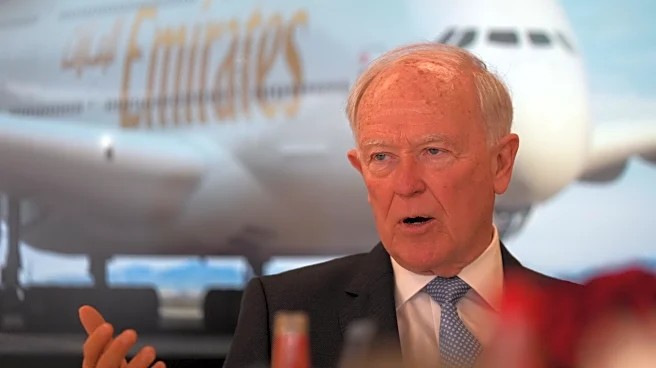What's Happening?
Boeing has projected a significant increase in demand for widebody aircraft in the Middle East over the next two decades. According to Darren Hulst, vice president of Boeing's Commercial Marketing division,
the region will require approximately 1,370 new widebody aircraft, split between the 787 and 777X family size categories. This demand is driven by the rapid growth of air traffic in the Middle East, which is outpacing the global average. The forecast indicates that the fleet in the region will more than double in size, necessitating nearly 3,000 new aircraft deliveries. The Middle East's capacity needs are expected to focus on the 390 seat-plus market segment, with airlines like Emirates and Qatar playing a significant role in this demand.
Why It's Important?
The projected increase in widebody aircraft demand in the Middle East highlights the region's growing influence in global aviation. This demand is likely to benefit major aircraft manufacturers like Boeing and Airbus, as they cater to the needs of Middle Eastern airlines. The expansion of fleets in the region could lead to increased connectivity and economic growth, as airlines expand their routes and services. Additionally, the focus on larger aircraft models suggests a shift towards accommodating more passengers per flight, which could enhance operational efficiency and profitability for airlines. The demand for widebody aircraft also underscores the strategic importance of the Middle East as a hub for international travel and commerce.
What's Next?
As the demand for widebody aircraft in the Middle East continues to rise, Boeing and Airbus may need to explore the development of stretched, higher passenger capacity versions of existing models like the A350-1000 and 777-9. This could involve significant research and development efforts to meet the specific needs of Middle Eastern airlines. Additionally, airlines in the region may continue to expand their fleets and routes, further solidifying their position as key players in global aviation. The increased demand could also lead to more competitive pricing and service offerings, benefiting passengers and boosting tourism and business travel in the region.
Beyond the Headlines
The surge in widebody aircraft demand in the Middle East may have broader implications for the global aviation industry. As airlines in the region expand their fleets, there could be increased pressure on infrastructure, including airports and maintenance facilities, to accommodate larger aircraft and higher passenger volumes. This growth may also drive advancements in aviation technology and sustainability, as manufacturers and airlines seek to improve fuel efficiency and reduce environmental impact. Furthermore, the expansion of Middle Eastern airlines could influence global travel patterns, with more passengers choosing to transit through the region's hubs.













